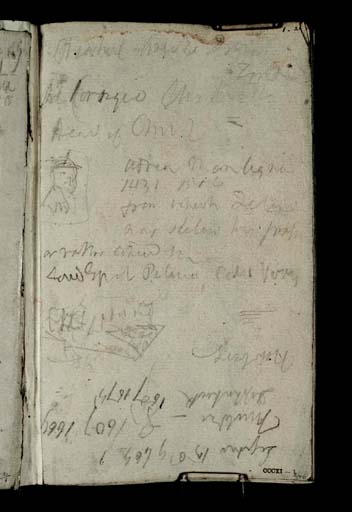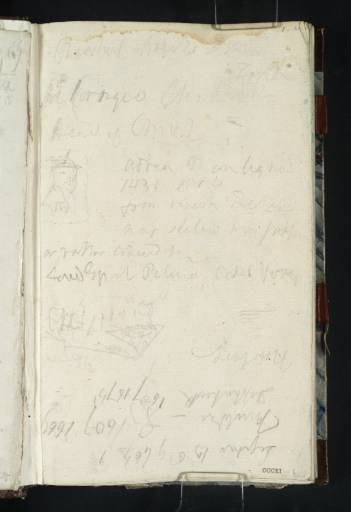Joseph Mallord William Turner Two Sketches, Including One of a Painting in the Imperial Picture Gallery in Vienna: Venetian School, 'Ecce Homo' 1833
Image 1 of 2
-
 Joseph Mallord William Turner, Two Sketches, Including One of a Painting in the Imperial Picture Gallery in Vienna: Venetian School, 'Ecce Homo' 1833
Joseph Mallord William Turner, Two Sketches, Including One of a Painting in the Imperial Picture Gallery in Vienna: Venetian School, 'Ecce Homo' 1833 -
 Joseph Mallord William Turner, Two Sketches, Including One of a Painting in the Imperial Picture Gallery in Vienna: Venetian School, 'Ecce Homo' 1833 (Enhanced image)Enhanced image
Joseph Mallord William Turner, Two Sketches, Including One of a Painting in the Imperial Picture Gallery in Vienna: Venetian School, 'Ecce Homo' 1833 (Enhanced image)Enhanced image
Joseph Mallord William Turner,
Two Sketches, Including One of a Painting in the Imperial Picture Gallery in Vienna: Venetian School, 'Ecce Homo'
1833
Joseph Mallord William Turner 1775–1851
Folio 1 Recto:
Two Sketches, Including One of a Painting in the Imperial Picture Gallery in Vienna: Venetian School, 'Ecce Homo' 1833
D31416
Turner Bequest CCCXI 1
Turner Bequest CCCXI 1
Pencil on off-white lined paper, 184 x 113 mm
Inscribed in pencil by Turner ‘[...] [...]’ | ‘[...] [?Corrgeo] [?Christ]’ top, ‘Head of Christ’ | ‘Adrea Mantegna | 1431 1506 | from which Titian | has stolen his [...] | or rather copied it | Lord Egremont Palma [...]’ centre, ‘S[...] 1501 604’ | ‘[...] 1607 1669’ | ‘D[...] 1607 1675’ | ‘Newberg’ bottom (inverted)
Inscribed in blue ink by Ruskin ‘1. 246’ top right and ‘246’ bottom right
Stamped in black ‘CCCXI – 1’ bottom right
Inscribed in pencil by Turner ‘[...] [...]’ | ‘[...] [?Corrgeo] [?Christ]’ top, ‘Head of Christ’ | ‘Adrea Mantegna | 1431 1506 | from which Titian | has stolen his [...] | or rather copied it | Lord Egremont Palma [...]’ centre, ‘S[...] 1501 604’ | ‘[...] 1607 1669’ | ‘D[...] 1607 1675’ | ‘Newberg’ bottom (inverted)
Inscribed in blue ink by Ruskin ‘1. 246’ top right and ‘246’ bottom right
Stamped in black ‘CCCXI – 1’ bottom right
Accepted by the nation as part of the Turner Bequest 1856
References
1909
A.J. Finberg, A Complete Inventory of the Drawings of the Turner Bequest, London 1909, vol.II, p.1000, CCCXI 1, as ‘Slight sketch of a picture (?), other sketches and various notes, dates, &c.’.
1995
Cecilia Powell, Turner in Germany, exhibition catalogue, Tate Gallery, London 1995, p.43, p.78 note 73.
1997
Ian Warrell, Turner on the Loire, exhibition catalogue, Tate Gallery, London 1997, p.105, p.209 note 121.
The ‘Head of Christ’ (inscribed) wearing a crown of thorns is depicted in the rough sketch squared off at left. This is a copy of an Ecce Homo by an unknown Venetian School artist hanging in the Imperial Picture Gallery at the Upper Belvedere, Vienna.1 Turner has made similar sketches on the folio opposite (Tate D41262).
Inscriptions around the sketch reveal possible influences for the painting. ‘[?Corrgeo] [?Christ]’ inscribed above ‘Head of Christ’, for example, may be a reference to Christ as the Man of Sorrows formerly attributed to Correggio (1489–1534) in the Dresden Gemäldegalerie. A renowned collection in Turner’s day, this painting was engraved and published in at least three versions.2 Turner would visit the Gemäldegalerie two years later in 1835, copying paintings there by Correggio and other old masters he had long admired.3
According to another inscription, ‘Adrea Mantegna | 1431 1506 | from which Titian | has stolen his [...] | or rather copied it’, Andrea Mantegna (1431–1506) and Titian (1490–1536) were also considered possible influences. Both artists painted the Ecce Homo, and here Turner appears to state his opinion that Titian drew direct influence from Mantegna in his treatment of the subject.
The inscription ‘Lord Egremont Palma [...]’ seems to refer to a different painting: one which may have reminded Turner of a work in the collection of his close friend and patron, George Wyndham, 3rd Earl of Egremont. In this case ‘Palma’ most probably refers to Palma Vecchio (Jacopo Palma, c.1480–1528), whose painting A Blonde Woman hung at Egremont’s seat Petworth House (now in the National Gallery, London).4
The remaining inscriptions, rendered with the sketchbook turned upside down relative to the foliation, are lists of dates: ‘S[...] 1501 604’ | ‘[...] 1607 1669’ | ‘D[...] 1607 1675’. ‘Newberg’, inscribed to the left of a rough sketch of a building or hill, may refer to the Neuberg, a hill just outside of Vienna.
For more views of Vienna in this sketchbook, see Tate D31417, D31421–D31423, D31425–D31440, D31442–D31442, D31446–D31452, D31454–D31458, D31470–D31471, D31542, D31592, D31596; Turner Bequest CCCXI 1a, 3a–4a, 5v–13, 14–15, 16–19, 20–22, 28–28a, 64a, 92, 94. For views in the 1840 Trieste, Graz and Danube sketchbook see Tate D30008, D30011, D30013, D30019, D30076–D30077; Turner Bequest CCXCIX 4, 5a, 6a, 9a, 40–40a.
Venetian School, Ecce Homo, 1580–90, oil on canvas, Kunsthistorisches Museum Wien, Gemäldegalerie (1827) www.khm.at/de/object/f8c0c96863/ >
See particularly British Museum, London, no. 1837,0408.92 http://www.britishmuseum.org/research/collection_online/collection_object_details.aspx?objectId=1559709&partId=1&searchText=correggio,+christ&page=1 > see also nos.1837,0408.90 and 1837,0408.91. For more on Turner’s engagement with Correggio, see David Blayney Brown, ‘Commentary on Correggio’s ‘St Jerome’ (Inscription by Turner) 1802 by Joseph Mallord William Turner’, catalogue entry, July 2005, in David Blayney Brown (ed.), J.M.W. Turner: Sketchbooks, Drawings and Watercolours, Tate Research Publication, December 2012, https://www.tate.org.uk/art/research-publications/jmw-turner/joseph-mallord-william-turner-commentary-on-correggios-st-jerome-inscription-by-turner-r1129727, accessed 06 September 2017 and David Blayney Brown, ‘St Jerome, after Correggio, and Colour Trials 1802 by Joseph Mallord William Turner’, catalogue entry, July 2005, in David Blayney Brown (ed.), J.M.W. Turner: Sketchbooks, Drawings and Watercolours, Tate Research Publication, December 2012, https://www.tate.org.uk/art/research-publications/jmw-turner/joseph-mallord-william-turner-st-jerome-after-correggio-and-colour-trials-r1129767, accessed 06 September 2017.
See Alice Rylance-Watson, ‘Two Paintings in the Dresden Picture Gallery: Correggio, 'Madonna with St George'; Correggio, 'Madonna with St Francis'; Dresden: The Kreuzkirche, Dresden 1835 by Joseph Mallord William Turner’, catalogue entry, May 2015, in David Blayney Brown (ed.), J.M.W. Turner: Sketchbooks, Drawings and Watercolours, Tate Research Publication, August 2017, https://www.tate.org.uk/art/research-publications/jmw-turner/joseph-mallord-william-turner-two-paintings-in-the-dresden-picture-gallery-correggio-r1186905, accessed 06 September 2017.
Palma Vecchio, A Blonde Woman, c.1520, oil on wood, 77.5 x 64.1 cm, National Gallery, London, https://www.nationalgallery.org.uk/paintings/palma-vecchio-a-blonde-woman >
Technical notes:
Water stains, presumably from the Tate flood of 1928, are present at the top upper edge. The folio is mounted on a modern paper stub.
Alice Rylance-Watson
September 2017
How to cite
Alice Rylance-Watson, ‘Two Sketches, Including One of a Painting in the Imperial Picture Gallery in Vienna: Venetian School, 'Ecce Homo' 1833 by Joseph Mallord William Turner’, catalogue entry, September 2017, in David Blayney Brown (ed.), J.M.W. Turner: Sketchbooks, Drawings and Watercolours, Tate Research Publication, March 2023, https://www

